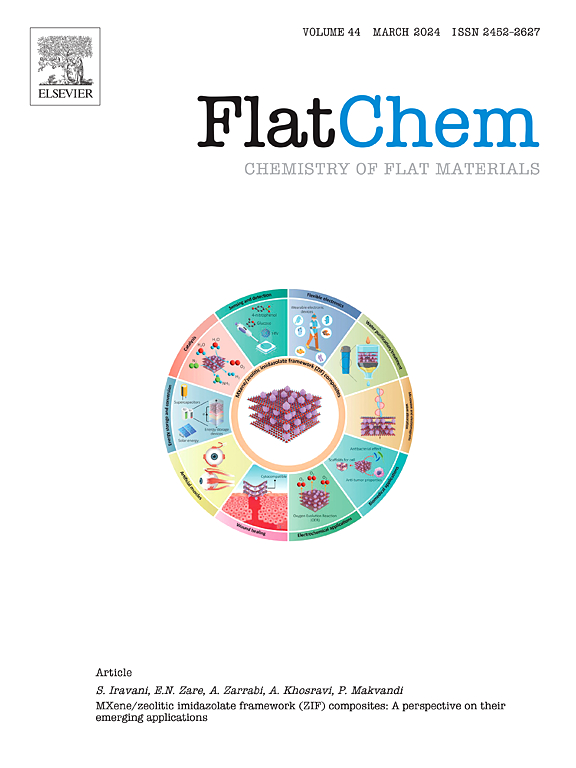Properties of yttrium based MXenes and the effect of its functionalization: A DFT study
IF 6.2
3区 材料科学
Q2 CHEMISTRY, PHYSICAL
引用次数: 0
Abstract
This article explores the implications of surface functionalization with hydroxide, fluorine, chlorine, and bromine functional groups on structural, dynamical, mechanical, electronics, optical and thermal characteristics of single layer Y2XZ2 MXenes (X signifies C or N, Z corresponds to OH, F, Cl, and Br) with the help of Vienna Ab initio Simulation Package (VASP). The outcomes show that functionalization considerably influences the vibrational, mechanical, electronics, thermal and optical properties of Y2XZ2. Notably, functionalization increases its mechanical properties. Furthermore, functionalization converts metallic characteristics of Y2C MXenes into semiconductor behavior, but Y2NZ2 retain their metallic nature. Real and imaginary components of dielectric function also depend on specific functional groups. In the NIR region, Y2N showed a negative magnitude of real part. Importantly, a correlation has been observed between the band gap and Seebeck coefficient, higher band gaps resulting in higher values of Seebeck coefficients at a given temperature. These findings have significant implications for the development of advanced technology in nanoelectronics and optoelectronics fields.

钇基MXenes的性质及其功能化的影响:DFT研究
本文借助维也纳从头算模拟程序(VASP),探讨了氢氧化物、氟、氯和溴官能团的表面功能化对单层Y2XZ2 MXenes (X表示C或N, Z对应OH、F、Cl和Br)的结构、动力学、机械、电子、光学和热特性的影响。结果表明,功能化对Y2XZ2的振动、力学、电子学、热学和光学性能有显著影响。值得注意的是,功能化提高了其机械性能。此外,功能化将Y2C MXenes的金属特性转化为半导体行为,但Y2NZ2保留其金属性质。介电函数的实、虚分量也依赖于特定的官能团。在近红外区,Y2N实数部呈负幅度。重要的是,已经观察到带隙和塞贝克系数之间的相关性,在给定温度下,更高的带隙导致更高的塞贝克系数值。这些发现对纳米电子学和光电子学领域先进技术的发展具有重要意义。
本文章由计算机程序翻译,如有差异,请以英文原文为准。
求助全文
约1分钟内获得全文
求助全文
来源期刊

FlatChem
Multiple-
CiteScore
8.40
自引率
6.50%
发文量
104
审稿时长
26 days
期刊介绍:
FlatChem - Chemistry of Flat Materials, a new voice in the community, publishes original and significant, cutting-edge research related to the chemistry of graphene and related 2D & layered materials. The overall aim of the journal is to combine the chemistry and applications of these materials, where the submission of communications, full papers, and concepts should contain chemistry in a materials context, which can be both experimental and/or theoretical. In addition to original research articles, FlatChem also offers reviews, minireviews, highlights and perspectives on the future of this research area with the scientific leaders in fields related to Flat Materials. Topics of interest include, but are not limited to, the following: -Design, synthesis, applications and investigation of graphene, graphene related materials and other 2D & layered materials (for example Silicene, Germanene, Phosphorene, MXenes, Boron nitride, Transition metal dichalcogenides) -Characterization of these materials using all forms of spectroscopy and microscopy techniques -Chemical modification or functionalization and dispersion of these materials, as well as interactions with other materials -Exploring the surface chemistry of these materials for applications in: Sensors or detectors in electrochemical/Lab on a Chip devices, Composite materials, Membranes, Environment technology, Catalysis for energy storage and conversion (for example fuel cells, supercapacitors, batteries, hydrogen storage), Biomedical technology (drug delivery, biosensing, bioimaging)
 求助内容:
求助内容: 应助结果提醒方式:
应助结果提醒方式:


